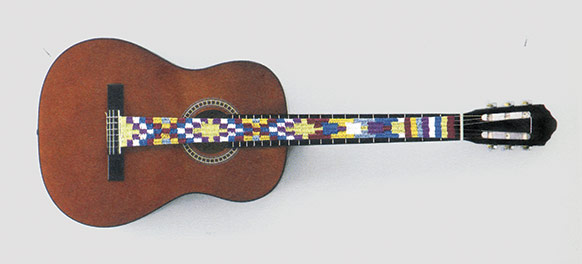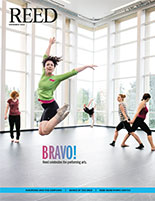
IRIS login | Reed College home Volume 92, No. 4: December 2013
Reediana Briefs

Rug Woogie V, 2011, performance on guitar with yarn, by Jamie Isenstein ’98 from Will Return, edited by Stephanie Snyder ’91.

The Mason Gaffney Reader: Resolving “Unsolvable” Economic Problems, by Mason Gaffney ’48 (Henry George Institute, 2013). Such dismal dilemmas economists pose for us, these days. We’re told that to attract business we must lower taxes, shut the libraries, and starve the schools; to prevent inflation we must have millions of people unemployed; to make jobs we must chew up land and pollute the world; to motivate workers we must have unequal wealth; to raise productivity we must fire people. Mason has devoted his career to demonstrating the viability of reconciliation and synthesis in economic policy. In these 21 wide-ranging essays, he shows how we can find “win-win-win” solutions to many of society’s seemingly “unsolvable” problems. Economist James Galbraith describes the book as a “crisp cocktail of geography, history and economics, chilled by crackling-clear prose.”

Songs and Dances of the Oregon Trail and Early Pioneer Communities by Phil Williams ’58 and Vivian Tomlinson Williams ’59 (Voyager Recordings & Publications, 2012). Most journals and accounts of the pioneers who traveled on the Oregon Trail dwell on the hardships of the long journey through the wilderness to new homes in the West. However, there was a happier side to this adventure that some pioneers wrote about—the songs they sang around evening campfires and the dances they had on the open prairie, accompanied by fiddle and banjo. The book includes 60 songs and dance tunes and instructions for 17 dances and play parties—all well researched for historical accuracy—making this a valuable asset for teachers and anyone else interested in performing Oregon Trail music and dance. Written and edited by Phil and Vivian, the book is typeset in the SCORE music-engraving program.

Edward, by Graham Seibert ’64 (eBook, Amazon, 2013). In his book, Graham describes a plan to home-school his son, Edward, in his mother’s homeland, Ukraine. Character is key: if he is honest and dependable, Edward will be a success. Pride and respect for himself and his ancestors are essential inspirations to be a good husband, father, and provider. Graham’s experience as a parent, private school trustee, teacher, and student led to the conviction that, in educating a second family, he had to take control of the process. This book describes why and how. The key insight is that knowledge is built by the child himself. A teacher can only encourage the process. One must sustain the child’s own motivation, totally evident in a two-year-old, yet stifled in the average ten-year-old. Success comes when the student feels interested and in control . . . in his studies and all his life.

Pride and Prejudice and Kitties: A Cat-Lover’s Romp Through Jane Austen’s Classic, by Debbie Guyol ’68 (Skyhorse Publishing, 2013). Deborah teamed up with children’s author Pamela Jane and served as photographer for this rendition of a novel she has loved since her teen years and has now committed to memory. The book is described as “a unique, cleverly written, and utterly hysterical retelling of Pride and Prejudice. Presented with reverence to the classic novel.” Says Debbie, “I am putting my Reed education to excellent use!”

圣

7 Days and Nights in the Desert (Tracing the Origin), by Sabrina Dalla Valle ’90 (Kelsey Street Press, 2013). Composed in a hybrid form that braids personal narrative with philosophical reflections, Sabrina’s book ponders the complexities of human communication and perception. The book received the 2012 Kelsey Street Press prize for best first book, judged in a blind contest by Mei-mei Berssenbrugge ’69.

Communicating Popular Science: From Deficit to Democracy, by Sarah Perrault ’91 (Palgrave Macmillan 2013). In this scholarly book on science popularization, Sarah explains how science writing works and argues that it can do better at promoting public discussions about science-related issues. To support these arguments, it situates science popularization in its historical and cultural context; provides a conceptual framework for analyzing popular science texts; and examines the rhetorical effects of common strategies used in popular science writing. Sarah is assistant professor of rhetoric and writing in the University Writing Program at University of California, Davis.

Jamie Isenstein: Will Return, Stephanie Sakellaris Snyder ’91, editor (Cooley Art Gallery, 2013). Stephanie, director of the Cooley Gallery, served as curator of the gallery’s exhibition Jamie Isenstein: Will Return, which featured the work of artist Jamie Isenstein ’98 in the fall. Stephanie also edited a full color, 130-page exhibition catalog, with the objects, drawings, mixed-media sculptures, and installations that engage the artist’s body as an artistic medium—“a subject of humor, theatricality, and historical representation,” Stephanie says. “There aren’t many works of art that compel you to laugh out loud or break into a smile, but Isenstein’s do. They delight, amuse, and titillate.” The catalog contains splendid reproduction of Jamie’s work. Also included in the catalog are Jamie and Stephanie “In Conversation”; an essay by Graham Jones ’97, MIT anthropologist and an expert on the subculture of entertainment magic; and notes by David Velasco ’00, editor of Artforum.

A Companion to the Philosophy of Time, by Adrian Bardon ’92, coeditor (Wiley-Blackwell, 2013). Adrian coedited this compilation of 32 articles, contributed by distinguished and rising scholars in the field. The book is the most comprehensive reference work on the philosophy of time to date and is the first collection to tackle the historical development of the philosophy of time, in addition to covering contemporary work. Further, it provides a tripartite approach in its organization, covering history of the philosophy of time, time as a feature of the physical world, and time as a feature of experience.

德

Th

妈

Bikenomics: How Bicycling Can Save the Economy, by Elly Blue ’05 (Microcosm Publishing, 2013). Elly provides a surprising and compelling new perspective on the way we get around and on how we spend our money, as families and as a society. She begins with a look at the real transportation costs of families and individuals, and moves on to examine the current civic costs of our transportation system, relating stories of people, businesses, organizations, and cities that are investing in two-wheeled transportation. The multifaceted North American bicycle movement is revealed, with its contradictions, challenges, successes, and visions.

Absence & Presence, by Lisa M. Steinman, Kenan Professor of English & Humanities [1976–] (University of Tampa Press, 2013). In her sixth volume of poetry, Lisa considers mortality and memory, the seen and unseen, and “meditatively engages the ironies of being,” says Maxine Scates [English, 1989–2006]. Author Alice Fulton remarks that Lisa’s poetry in Absence & Presence “confronts the most unsparing aspects of existence with an intelligence that is nothing short of revelatory.” In addition to her collections of poetry, Lisa has also written three books about poetry. Her work has received recognition from the National Endowment for the Arts and the National Endowment for the Humanities and an Individual Artist Fellowship award from the Oregon Arts Commission. With her husband, Jim Shugrue, former visiting writer and tradebook buyer at Reed, she coedits the poetry magazine Hubbub, now in its 30th year.

LATEST COMMENTS
steve-jobs-1976 I knew Steve Jobs when he was on the second floor of Quincy. (Fall...
Utnapishtim - 2 weeks ago
Prof. Mason Drukman [political science 1964–70] This is gold, pure gold. God bless, Prof. Drukman.
puredog - 1 month ago
virginia-davis-1965 Such a good friend & compatriot in the day of Satyricon...
czarchasm - 4 months ago
John Peara Baba 1990 John died of a broken heart from losing his mom and then his...
kodachrome - 7 months ago
Carol Sawyer 1962 Who wrote this obit? I'm writing something about Carol Sawyer...
MsLaurie Pepper - 8 months ago
William W. Wissman MAT 1969 ...and THREE sisters. Sabra, the oldest, Mary, the middle, and...
riclf - 10 months ago